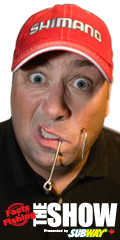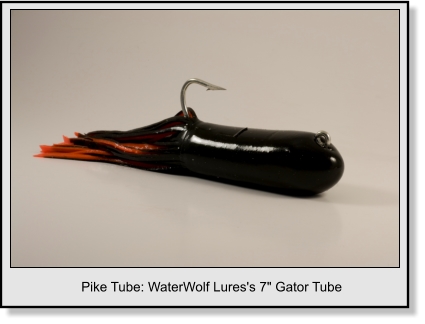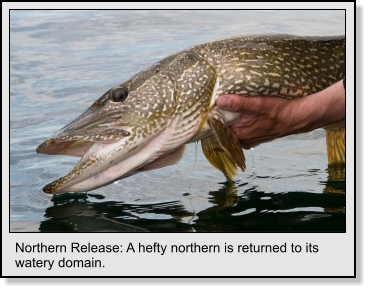

Editors & Publishers
T.J. & Monique Quesnel
The
Ontario Fishing Network
E-Magazine is
published 12 times a year on or near the beginning of every month. Our
magazine is geared to any angler who enjoys fishing of any type in the
wonderfully diverse province of Ontario.
Editorial Submissions: We welcome query letters,
but assume no responsibility for unsolicited materials.
Subscriptions: Subscriptions are FREE of charge
and delivered via email.
You can subscribe
HERE:
Privacy Policy: Unlike other publications We
NEVER make our subscribers list (your email address) available to any
other companies.
Advertising: If you are interested in advertising
please email us.
Circulation - 10,700 email subscribers
© 2009 Due North
Marketing / Ontario Fishing Network / T.J. Quesnel. All rights
reserved. Reproduction of any material without prior written
permission strictly prohibited.
Bay of
Quinte Fishing
|
 Big
Tube Jigs for Autumn Pike Big
Tube Jigs for Autumn Pike
By Tim Allard
Shorter days and cooling water are signals to northern pike that
autumn has arrived. During fall, these sleek predators will feed
heartily to pack on energy reserves to help them survive winter's
hardships. There are few better ways to catch pike in cold-water
than using big profile jigs, and giant tubes are a particularly
productive bait.
Pike Locations from Early Fall to Ice Up
Fall is very much a time of transition. At the start of autumn pike
will still relate to healthy weeds but as shallow plants die look
for northerns in deeper vegetation zones. Tributaries and the mouths
of feeder streams on rivers are also good late season spots as
baitfish stage in these areas. Sharp breaks where walleye hold will
also attract pike, which will eat walleye any chance they get.
Rock-gravel reefs and points adjacent to deep water are good
whitefish and cisco (lake herring) spawning grounds. These two prey
species spawn between November and December, so these structures
make prime late-fall pike spots.
Current areas also attract pike year round. As an example, on lakes
the narrows between shore and an island often has wind-induced
current travelling through it. This pushes in baitfish and pike
follow. A particularly productive zone in autumn, however, is the
tail water below river and reservoir dams. Baitfish congregate here
in numbers as do walleye and sauger. Northerns wait in ambush in
current breaks like eddies, outwash holes, and deep pools.

Basic Tube Jigs Tips
Big tube jigs between five and seven inches are a supreme autumn
bait. The bait's thickness also appeals to northerns stocking up on
calories. When pike are sluggish as a result of cold water these
baits also have just enough action to get fish interested. Their
multi-filament appendages wave at the slightest movement and are
deadly at triggering bites when pike are sluggish. Tubes are
outstanding lures to work on swimming retrieves. Pumping the rod tip
during the retrieve will add either a side-to-side twitch or an
up-and-down bob to the tube depending on its rigging.
When fishing tubes near bottom, be alert and keep a feel on the bait
at all times as it sinks. Tubes fall in a shimmy or a spiral that
imitates a dying fish and pike often strike during the initial drop.
Once on bottom you can use either a lazy, lift-drop swim or a
drag-pause retrieve.
 Hooking
Followers Hooking
Followers
Fall fish can be lazy and follows are common. The best scenario is
spotting an aggressive fish a distance from the boat. In this case,
try speeding up the retrieve or adding some snaps. This imitates
escape-moves and sometimes triggers bites. If the fish appears lazy,
slow the retrieve slightly. If working the bait along bottom add
pauses or experiment with the length of drags. Slow twitches that
impart an escape-like dart to tubes can also evoke strikes. If you
spot a following pike close to the boat while your jig is travelling
upwards, letting out line so the jig falls is your best option.
Tackle Tips
Rig tube jigs using a long-shank jig head. Large baits featuring a
wide body cavity will accommodate a range of jig head styles. Also,
adding a stinger treble hook on a wire leader to large seven inch
tubes can help with hook-up rates when pike bite short.
Big tubes demand heavy gear. I use heavy-power baitcast outfits. For
deep water applications, I like rods to be at least seven feet, but
I prefer seven-and-a-half feet for better line control when drifting
and moving line for deep water hook sets.
This autumn try casting tube jigs around deep weed edges and rocky
structures. This non-traditional tactic is a great way to boat
bragging sized northern pike.
|